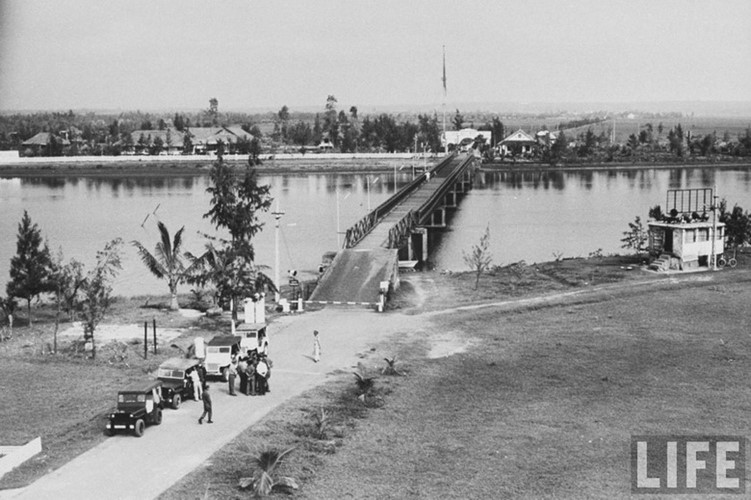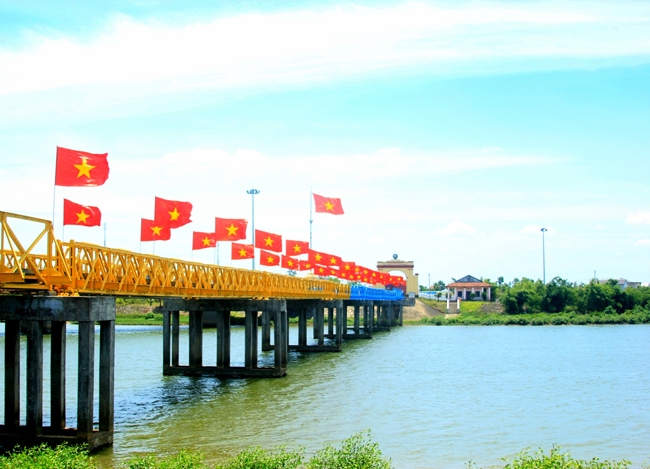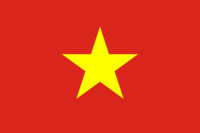Hien luong bridge
Hien luong bridge is a place that witnessed intense “flag-waving” and “loudspeaker battles” during the Vietnam War. During that era, Hien Luong was the bridge across the Bến Hải River, which served as the border dividing Vietnam into two regions along the 17th parallel: the North, administered by the Democratic Republic of Vietnam, and the South, initially controlled by the State of Vietnam, and later by the Republic of Vietnam and then the Socialist Republic of Vietnam, spanning nearly 22 years from 1954 to 1976.
See more: Vinh Moc tunnel

Construction History Before the existence of the bridge across the narrow river, which was less than 100 meters wide, there was only a ferry. The first Hien Luong bridge was built in 1928, with local contributions under the leadership of the Vĩnh Linh district authorities. This bridge was made of wood, supported by iron piles, 2 meters wide, and could only accommodate pedestrians. In 1931, the bridge was repaired by French Indochina, but vehicles still had to cross the river by ferry. In 1943, the bridge was upgraded once again, making it possible for small motor vehicles to cross the river.
By 1950, due to military demands, the French constructed a concrete and steel-reinforced bridge, 162 meters long, 3.6 meters wide, and capable of carrying loads of up to 10 tons. This bridge existed for only two years before being destroyed by Viet Minh guerrillas to obstruct the French advance. In May 1952, the French built a new bridge consisting of 7 spans, 178 meters long, with concrete and steel-reinforced pillars, steel beams, a wooden deck, 4 meters wide, and protective walls 1.2 meters high on each side, with a maximum load capacity of 18 tons.
“The bridge is divided into two parts, each 89 meters long, painted in two different colors. The north bank consists of 450 wooden deck panels, while the south bank has 444 panels.”
—Writer Nguyễn Tuân
This bridge lasted for 15 years (from 1952 to 1967) before being bombed by the United States.
From 1972 to 1974, to serve the battlefield in South Vietnam, the Combat Engineers of the Republic of Vietnam relocated the Bailey bridge about 20 meters upstream from the old bridge. In 1974, the government of the Socialist Republic of Vietnam rebuilt it with a reinforced concrete structure, 186 meters long, 9 meters wide, and a 1.2-meter-wide pedestrian walkway.
After the restoration of peace, the old bridge deteriorated significantly. In 1996, the Ministry of Transport constructed a new bridge, 230 meters long, 11.5 meters wide, next to the old bridge, facing upstream. The new bridge was constructed using the incremental launching method, the most modern technology applied in Vietnam for the first time. In 2001, the iron bridge from 1952, a historical relic of the country’s division, was restored to its original design, resembling the old bridge bombed by the United States in 1967.
On May 18, 2003, Quảng Trị province inaugurated the restored Hien Luong bridge across the Bến Hải River. The project was initiated in April 2002, with a total investment of 6.5 billion Vietnamese đồng. The restored bridge is 182.97 meters long with 7 spans, featuring a hardwood deck.
History of the Vietnam Division In 1954, following their strategic defeat at the Battle of Điện Biên Phủ, France agreed to grant independence to Vietnam under the Geneva Accords. The Bến Hải River at the 17th parallel was chosen as the demarcation line that divided Vietnam into two military zones: the Democratic Republic of Vietnam (North Vietnam), controlled by the Viet Minh, and the State of Vietnam (South Vietnam), initially governed by the State of Vietnam and later by the Republic of Vietnam, and ultimately managed by the Socialist Republic of Vietnam. Initially, the division of the country into these two military zones did not imply territorial or political separation and was meant to last for only two years, from 1954 to 1956, after which general elections were to be held to reunify the nation. According to the agreement, the Viet Minh forces from the South had to withdraw to the North, while French forces from the North had to withdraw to the South. Between these two military zones was a “Demilitarized Zone” extending 5 kilometers from each side of the Bến Hải River, designated as a “buffer zone” to prevent potential hostilities between the two armies.
However, in 1956, Ngô Đình Diệm, the President of the State of Vietnam, refused to participate in the general elections, prolonging the division of the country and causing a political crisis. This division would eventually lead to the Vietnam War, which lasted until 1975 when North Vietnam emerged victorious and reunified the country under communist rule.

Symbolism of Hien Lương bridge, is significant for several reasons:
- Symbol of Division: The bridge serves as a powerful symbol of the physical division of Vietnam into North and South during the Vietnam War. It was located at the heart of the Demilitarized Zone (DMZ) that separated the two regions, and it became a focal point for negotiations, confrontations, and symbolic actions by both sides during the conflict.
- Flag-Waving and Loudspeaker Battles: The bridge was the site of intense propaganda efforts by both North and South Vietnam. Soldiers from the North and South would engage in “flag-waving” and “loudspeaker battles,” where they would display their respective national flags and broadcast propaganda messages across the river to the opposing side.
- Restoration and Reconciliation: After the war ended in 1975, efforts were made to restore the bridge and promote reconciliation between North and South Vietnam. The restoration of Cầu Hiền Lương and its status as a historical relic reflect the country’s desire to heal the wounds of war and move forward as a unified nation.
- Tourist Attraction: Today, Hien Luong bridge has become a tourist attraction, drawing visitors who are interested in Vietnam’s history and the legacy of the Vietnam War. It serves as a reminder of the country’s past and its journey toward reunification and reconciliation.
Hien Luong bridge stands as a symbol of both the division and eventual reunification of Vietnam, representing the resilience and determination of the Vietnamese people to overcome the challenges of war and build a unified nation.

